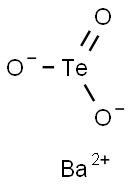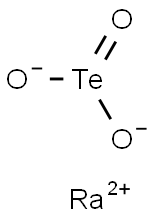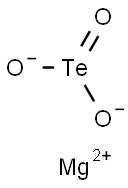Hydrogen telluride
- CAS NO.:7783-09-7
- Empirical Formula: H2Te
- Molecular Weight: 129.61588
- SAFETY DATA SHEET (SDS)
- Update Date: 2023-10-17 17:11:58

What is Hydrogen telluride?
Description
Hydrogen telluride has the formula, H2Te. The simplest hydride of Te, it is rarely encountered because of its tendency to decompose to the constituent elements. Most compounds with Te–H bonds are unstable with respect to loss of H2. H2Te is chemically and structurally similar to H2S, and both are acidic species with H–X–H angles approaching 90°.The tellurides of the alkaline earth metals tend to immediately decompose on exposure to air, with liberation of tellurium. H2Te is prepared by the acidification of salts of Te2-,such as Al2Te3 and Na2Te.
Na2Te can be generated by the reaction of Na and Te in anhydrous ammonia. The intermediate in the acidification, the HTe is a stable anion.
H2Te is an endothermic compound, and is unstable in air, rapidly decomposing into water and elemental tellurium:
2H2Te+ O2 → 2H2O+ 2Te
It is almost as acidic as phosphoric acid (pKa=8.1×10-3), having a pKa value of about 2.3×10-3. It reacts with many metals to form tellurides. However, many of these are unstable relative to their decomposition to the elements. Its CAS number is 7783-09-7 and its molecular weight is 129.6158 g/mol. It is a colorless gas and is toxic if breathed. Its density is 3.310 g/cm3 and its melting point is –49°C with a boiling point of –2.2°C. Its solubility in water is 0.701 g/100 ml of water at 20°C.
Chemical properties
Colorless gas.Soluble in water but unstable; soluble in alcohol and alkalies.
Physical properties
Colorless gas; strong garlic-like odor; stable to light when dry but under-goes photochemical decompostion in the presence of moisture and dust; den-sity 5.68 g/L; liquefies to a colorless unstable liquid at -2°C, decomposed bylight; liquid density 2.57 g/mL at -20°C; solidifies at -49°C; soluble in water,alcohol and alkalies; pKa 2.6 (for first dissociation constant at 18°C) and 11.0(the dissociation constant at 25°C) for the second replaceable hydrogen.
The Uses of Hydrogen telluride
It is synthesized by the action of acid on aluminum telluride. It has no industrial uses.
Preparation
Hydrogen telluride is prepared by the reaction of aluminum telluride,Al2Te3 with hydrochloric acid:
Al2Te3 + 6HCl → 3H2Te + 2AlCl3
It also may be prepared by electrolysis of a 50% sulfuric acid solution using atellurium cathode.
Hazard
See hydrogen selenide.
Properties of Hydrogen telluride
| Melting point: | -49° |
| Boiling point: | bp -2° |
| Density | dliq-12 2.68 |
| solubility | soluble in H2O, ethanol, alkaline solutions |
| form | colorless gas |
| color | colorless |
| Water Solubility | soluble H2O, unstable solution; soluble alcohol and alkalies [HAW93] |
| CAS DataBase Reference | 7783-09-7 |
Safety information for Hydrogen telluride
Computed Descriptors for Hydrogen telluride
New Products
Tert-butyl bis(2-chloroethyl)carbamate (S)-3-Aminobutanenitrile hydrochloride N-Boc-D-alaninol N-BOC-D/L-ALANINOL N-octanoyl benzotriazole 3,4-Dibenzyloxybenzaldehyde 4-Hydrazinobenzoic acid Electrolytic Iron Powder 1,1’-CARBONYLDIIMIDAZOLE R-2-BENZYLOXY PROPIONIC ACID 4-HYDROXY BENZYL ALCOHOL 1,1’-CARBONYLDI (1,2-4 TRIAZOLE) S-2-CHLORO PROPIONIC ACID (2-Hydroxyphenyl)acetonitrile 4-Bromopyrazole 5-BROMO-2CYANO PYRIDINE 5,6-Dimethoxyindanone 5-broMo-2-chloro-N-cyclopentylpyriMidin-4-aMine 3-(2,4-Dimethoxybenzyl)dihydropyrimidine-2,4(1H,3H)-dione 6-Bromo-3-iodo-1-methyl-1H-indazole N-Boc-L-proline methyl ester 2-(BOC-Amino)4-picoline 1-(4-Methylphenylsulfonyl)-1H-1,2,3-benzotriazole 1-(2-Chlorobenzyl)-4-nitro-1H-pyrazoleRelated products of tetrahydrofuran








You may like
-
 55441-95-7 2 2-BIS(2-HYDROXYETHOXY)-1 1-BINAPHTHYL 99%View Details
55441-95-7 2 2-BIS(2-HYDROXYETHOXY)-1 1-BINAPHTHYL 99%View Details
55441-95-7 -
 181228-33-1 99%View Details
181228-33-1 99%View Details
181228-33-1 -
 Ste-Glu-AEEA-AEEA-OSUView Details
Ste-Glu-AEEA-AEEA-OSUView Details
1169630-40-3 -
 1446013-08-6 Fmoc-His-Aib-OH TFA 98%View Details
1446013-08-6 Fmoc-His-Aib-OH TFA 98%View Details
1446013-08-6 -
 127464-43-1 99%View Details
127464-43-1 99%View Details
127464-43-1 -
 Chloro Uracil 99%View Details
Chloro Uracil 99%View Details
1820-81-1 -
 2-ETHYLPYRIDINE 100-71-0 99%View Details
2-ETHYLPYRIDINE 100-71-0 99%View Details
100-71-0 -
 13162-05-5 99%View Details
13162-05-5 99%View Details
13162-05-5